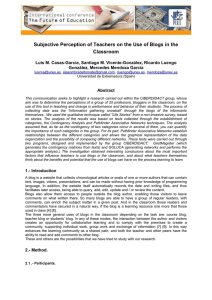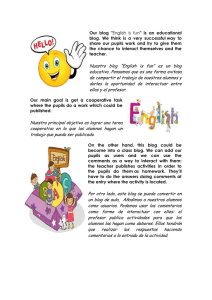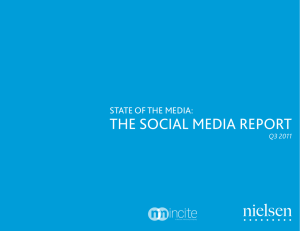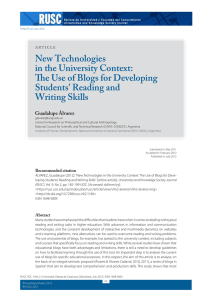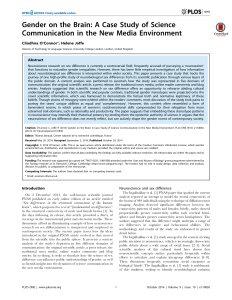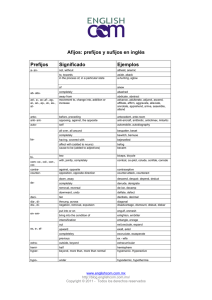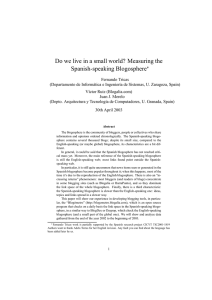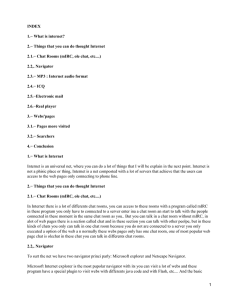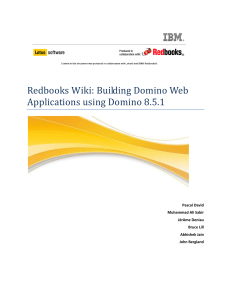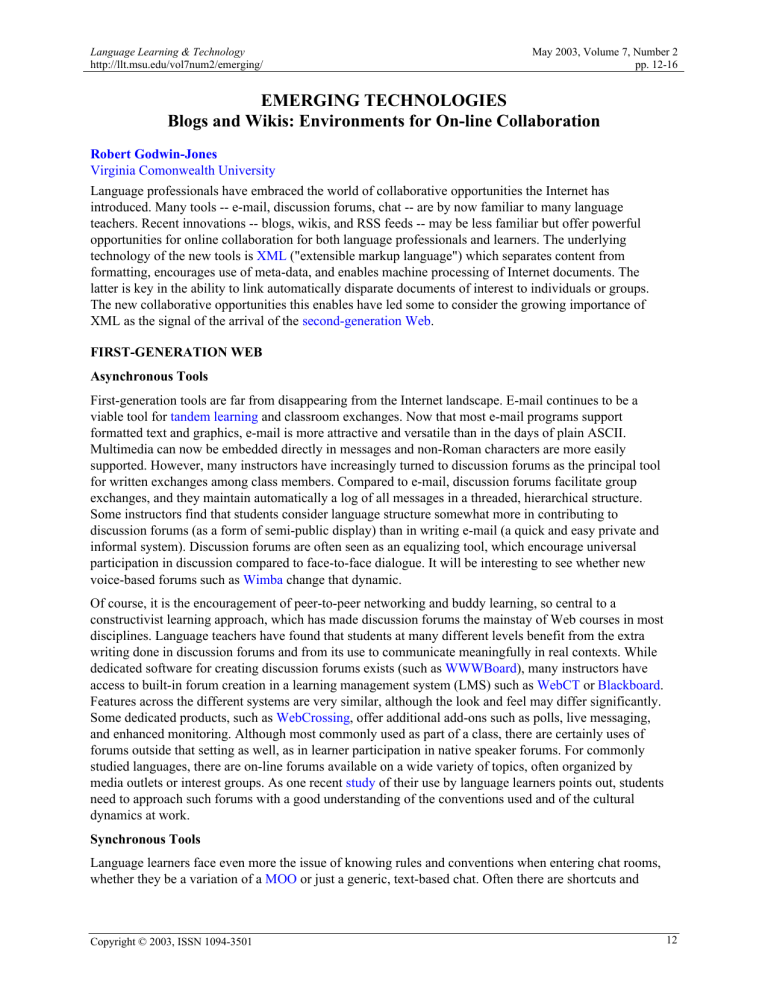
Language Learning & Technology http://llt.msu.edu/vol7num2/emerging/ May 2003, Volume 7, Number 2 pp. 12-16 EMERGING TECHNOLOGIES Blogs and Wikis: Environments for On-line Collaboration Robert Godwin-Jones Virginia Comonwealth University Language professionals have embraced the world of collaborative opportunities the Internet has introduced. Many tools -- e-mail, discussion forums, chat -- are by now familiar to many language teachers. Recent innovations -- blogs, wikis, and RSS feeds -- may be less familiar but offer powerful opportunities for online collaboration for both language professionals and learners. The underlying technology of the new tools is XML ("extensible markup language") which separates content from formatting, encourages use of meta-data, and enables machine processing of Internet documents. The latter is key in the ability to link automatically disparate documents of interest to individuals or groups. The new collaborative opportunities this enables have led some to consider the growing importance of XML as the signal of the arrival of the second-generation Web. FIRST-GENERATION WEB Asynchronous Tools First-generation tools are far from disappearing from the Internet landscape. E-mail continues to be a viable tool for tandem learning and classroom exchanges. Now that most e-mail programs support formatted text and graphics, e-mail is more attractive and versatile than in the days of plain ASCII. Multimedia can now be embedded directly in messages and non-Roman characters are more easily supported. However, many instructors have increasingly turned to discussion forums as the principal tool for written exchanges among class members. Compared to e-mail, discussion forums facilitate group exchanges, and they maintain automatically a log of all messages in a threaded, hierarchical structure. Some instructors find that students consider language structure somewhat more in contributing to discussion forums (as a form of semi-public display) than in writing e-mail (a quick and easy private and informal system). Discussion forums are often seen as an equalizing tool, which encourage universal participation in discussion compared to face-to-face dialogue. It will be interesting to see whether new voice-based forums such as Wimba change that dynamic. Of course, it is the encouragement of peer-to-peer networking and buddy learning, so central to a constructivist learning approach, which has made discussion forums the mainstay of Web courses in most disciplines. Language teachers have found that students at many different levels benefit from the extra writing done in discussion forums and from its use to communicate meaningfully in real contexts. While dedicated software for creating discussion forums exists (such as WWWBoard), many instructors have access to built-in forum creation in a learning management system (LMS) such as WebCT or Blackboard. Features across the different systems are very similar, although the look and feel may differ significantly. Some dedicated products, such as WebCrossing, offer additional add-ons such as polls, live messaging, and enhanced monitoring. Although most commonly used as part of a class, there are certainly uses of forums outside that setting as well, as in learner participation in native speaker forums. For commonly studied languages, there are on-line forums available on a wide variety of topics, often organized by media outlets or interest groups. As one recent study of their use by language learners points out, students need to approach such forums with a good understanding of the conventions used and of the cultural dynamics at work. Synchronous Tools Language learners face even more the issue of knowing rules and conventions when entering chat rooms, whether they be a variation of a MOO or just a generic, text-based chat. Often there are shortcuts and Copyright © 2003, ISSN 1094-3501 12 Robert Godwin-Jones Emerging Technologies: Blogs and Wikis… etiquette, which can prove confusing and frustrating to new users. Nevertheless, some language teachers have embraced the use of chat as an effective communication tool. The speed of chat exchanges forces short, spontaneous messages, which more closely mimic spoken exchanges than is the case in discussion forums. Transcripts of chat sessions may be available for some chat systems but are not normally possible in the variety of chat currently most widely used, instant messaging. Systems such as AOL Instant Messenger (AIM) or MSN Messenger allow creation of "buddy lists," searching for message partners through interest groups or by home country, and on-line/off-line status alerts. Students in some countries make frequent use of instant messaging but probably less commonly for educational purposes. Quick, informal discussions with native speakers, however, might well prove a useful adjunct in tandem or classroom exchanges. The attractiveness of instant messaging for language learners resides particularly in the addition of voice and video options for communication. The different tools currently available are discussed and evaluated in a recent LLT review. While the various tools such as iVisit, or PalTalk differ in the audio quality, the number of simultaneous users, and the support for different operating systems, all offer an incredible communicative power for the cost of an Internet connection. This is a far cry from the pricey and proprietary audio/video systems of the recent past. Of course, the use of multimedia can change significantly the group dynamics of discussions, bringing into play as they do personal appearance and individual/local language variations. Webcams can bring immediacy and a direct personal connection, which may or may not be welcome. Webcams have become both less expensive and more efficient in terms of picture size and transmission quality, with the best quality being achieved through use of Firewire or USB2 cameras. SECOND-GENERATION WEB Blogs The collaborative environment which has sparked the most intense interest in recent years are blogs or Web logs. If one thinks of blogs as being essentially on-line journals, it may not be evident how they could be used in collaborative ways. But actually looking at a few blogs (such as InstaPundit by Glenn Reynolds or Scripting News by Dave Winter) demonstrates how interactive they can be. Writers typically make rich use of hypertext to connect to what others have written on a topic or to resources on the Web. Blog entries are normally followed by a comment button, allowing readers to write a reaction, which is then logged and linked, along with all other comments, into the original text. While most blogs are created and managed by individuals, group blogs are also possible. Blogs are easily linked and crosslinked, to create larger on-line communities. That is now the case with technology-related blogs, which form what is essentially one, large, loosely interwoven net of information, as blog entries are linked, referenced, and debated. While blogs of all kinds abound today on the Internet, most are personal or journalistic. However, there has been increasing interest in using blogs in education. Blogs are well suited to serve as on-line personal journals for students, particularly since they normally enable uploading and linking of files. Language learners could use a personal blog, linked to a course, as an electronic portfolio, showing development over time. By publishing the blog on the Internet, the student has the possibility of writing for readers beyond classmates, not usually possible in discussion forums. Readers in turn can comment on what they've read, although blogs can be placed in secured environments as well. Self-publishing encourages ownership and responsibility on the part of students, who may be more thoughtful (in content and structure) if they know they are writing for a real audience. This same degree of personal responsibility is lacking in discussion forums. No knowledge of HTML (or of Web authoring in general) is needed for blogging. Typically a student creating a Web site using a tool such as Blogger registers as a user, and sets up a page using one of Language Learning & Technology 13 Robert Godwin-Jones Emerging Technologies: Blogs and Wikis… several available templates (or creating a new look). The writing interface in Blogger shown below is typical. Jim Duber has created a blog for CALL, while Aaron Campbell has put together a helpful set of pages for using Web logs in ESL classes. Campbell also runs his own blog, the New Tanuki, as a resource for his EFL students and others. As is typical of many blogs, Campbell posts his entries in a column in the center of the page, with two narrower columns on either side with links in the categories of English resources, class information, and daily news. Some of his postings are links to stories on other sites, others are written by him, still others are photos. Will Richardson has created a good example of a course blog for his journalism class at an American high school. As is common in blogs, Richardson combines personal messages with world events, along with class notes and assignments. There are extensive links to news services and journalism sites. Individual student blogs are linked to the course blog. The mix is eclectic and results in a course site very different from the rigid hierarchy to be found in the typical LMS class. Blackboard and WebCT use a top-down approach; blogs tend to go the other direction. They offer a great deal of flexibility and the potential for creativity in the construction of the site, yet still feature the ease of use of a template-based system. RSS and Wiki Blogs can serve as environments for project-based learning. However, a limitation in the structure of blogs is the fact that they are chronologically organized, rather than by content. There are however, indices of blogs as well as search mechanisms on the blogs themselves. There has also been interest in "structured blogging" to enhance the ability to find blog-based information. An example of such an initiative is blam!, a template tool for writing and collecting reviews (of books, CDs, etc.). It uses Amazon's Web services to gather the meta-data for an item, translates it into HTML, including any images and reference links. This is automatically placed into the editing environment, to be added to the writer's review. The review is then posted to a blog. One could envision such a tool for language lessons posted on the Web. The FLEX (Foreign Language Lesson Exchange) lesson typography at Virginia Commonwealth University (VCU) is a step in that direction. One of the technologies used by blogs to alert users to new postings, as well as to help sort information coming from multiple blogs and other Internet sources, are RSS feeds. RSS stands for "really simple syndication" and is an implementation of XML first developed by Netscape as a way for users to add "channels" to My Netscape pages. Subsequently, it has been further refined and developed, principally by Language Learning & Technology 14 Robert Godwin-Jones Emerging Technologies: Blogs and Wikis… Dave Winer, familiar to Mac developers as the creator of the Frontier scripting language. RSS supplies rich meta-data about Web-based resources, which can then be automatically retrieved and cataloged by RSS software, such as amphetaDesk or NetNewsWire, usually described as news readers or news aggregators. RSS feeds can also be read with the sidebar of Netscape 7. An RSS document contains at a minimum three elements: the title, the link (to the URL of the Web site containing the channel), and a brief description. RSS files are most commonly created with a text editor, but can also be written in an XML or HTML editor. While RSS feeds can help keep track of changes to blogs used as project centers, there is another collaborative environment which is more naturally suited for collaborative on-line projects, WikiWikliWeb (wiki wiki is Hawaiian for "quick") or wikis. Like blogs, wikis have been around for some time and are popular among technology buffs. The original WikiWikiWeb project is dedicated to software programming and is quite extensive. Blogs can be highly personal, wikis are intensely collaborative. They feature a loosely structured set of pages, linked in multiple ways to each other and to Internet resources and an open-editing system in which anyone can edit any page (by clicking on the "edit this page" button). No knowledge of HTML is needed, but whereas blogs tend to use a modified WYSIWYG editing environment, Wikis use a simple set of formatting commands. Such a system only works with users serious about collaborating and willing to follow the group conventions and practices. Of course, Wiki sites, like any pages on the Web, can be secured with password protection or other means, but wikis have built-in safeguards against malicious behavior (page changes are logged, page deletions must be seconded to take effect). The goal of Wiki sites is to become a shared repository of knowledge, with the knowledge base growing over time. Unlike chat rooms, wiki content is expected to have some degree of seriousness and permanence. There are wiki encyclopedia projects, including a number in languages other than English. The 21st-century Teaching and Learning project at Texas A&M University is built around a wiki, as is the conference planning process of the TESOL CALL interest section. A sample wiki site was set up by Awaji Yoshimana for the JALTCALL 2002 conference. Wiki sites can be created for specific projects with a set group of allowable users and provide an excellent collaborative environment, since changes are logged along with identification of the author. In fact, a wiki-type site could be ideal for a "community of practice" (COP), such as the ESL/EFL "Webheads in Action". A COP is a way of achieving collective applied learning with the expectation that over time expertise in a given subject area is developed and solutions to common issues and shared problems are found, posted and discussed. A COP might use a variety of collaborative tools, but its goal is to expand knowledge and improve practice in a specific area. As our access to information has grown exponentially in recent years, efforts like COPs provide a welcome means to share in knowledge management, one of the great challenges of our time. Resource List Computer-Mediated Communication • • • • • Relationships On the Line by Joan Cashion What is Computer-Mediated Communication? by Gerry Santoro Online/Virtual Learning Environments from Teresa d'Ea Digital Divide Network Using a Web-Based Course Management Tool to Support Face-to-Face Instruction Chat and Discussion Forums • • • Adjusting to MOOs by Nick Carbone Rationale for Chat in Language Learning from Vance Stevens Some CMC Clients Promoting Language Learning Through Chatting Online from Vance Stevens Language Learning & Technology 15 Robert Godwin-Jones • • • Emerging Technologies: Blogs and Wikis… To Chat or Not to Chat in the ESL Classroom from Teresa Almeida d'Ea Introducing EFL Students to Chat Rooms by Jo Mynard Internet Audio Communication For Second Language Learning: A Comparative Review of Six Programs from LLT, by Gary A. Cziko and Sujung Park Blogs • • • • • • • • • • • • • • • • • • • RSS • • • • • • InstaPundit.com well-known blog by Glenn Reynolds Seb's Open Research on how to make weblogs work, from Sbastien Paquet Peter Murphy's Panoramic VR Weblog weblog with panorama pictures Publishing a Project Weblog article describing creation and use of a weblog Towards structured Blogging about using blogs to provide more structured content (from Sbastien Paquet) Weblog Diffusion Index shows popularity of specficic Weblog pages (from MIT) Jim Duber on CALL blog dealing with language learning BLOGGER tool for creating blogs Audioblogger creation tool for voice-based blogs Pitas blog creation tool Asia Pacific Information Systems example of blog Weblogging: Another Kind of Website two-part series on blogs, includes eduational uses, from Chris Ashley Weblogg-ed using weblogs in education Educational Technology blog Weblogs for Use with ESL Classes by Aaron Patric Campbell The New Tanuki EFL blog from Aaron Patric Campbell Writing with Web logs by Kristen Kennedy What is Manila popular blog creation tool Courses Using Weblogs RSS explanation of "Really Simple Syndication" What is RSS from XML News syndic8 directory of 10,000 publicly available RSS feeds News Readers in the Open Directory client-side and server-side programs for reading RSS feeds News that Comes to You on RSS and Weblogs, from the Online Journalism Review News feeds from Germany from Syndic8 Wikis • • • • • • • • • PmWiki tool for developing wiki sites PmWikiPhilosophy rationale and theory behind wikis Wiki Sandbox demo site for trying out how a wiki works WikiWikiWeb information about wikis One Minute Wiki French quick introduction in French PhpWiki: a PHP WikiWikiWeb a wiki clone written in PHP Wanna Wiki Wiki? an Introduction to Wiki Wiki Web and Comparison of Wiki Clones, by Awaji Yoshimasa Jounalism 1 at HCRHS example of blog used in a secondary school Literacy Writing Project example of wiki for educational use Language Learning & Technology 16
